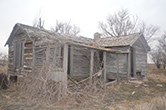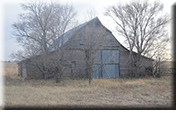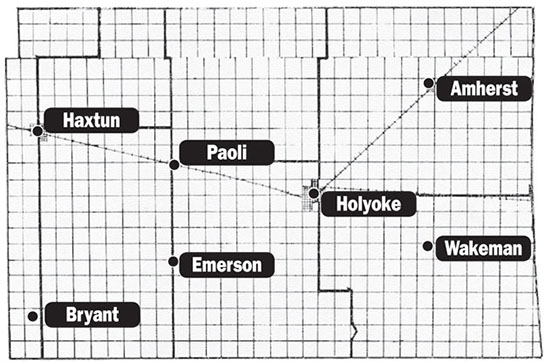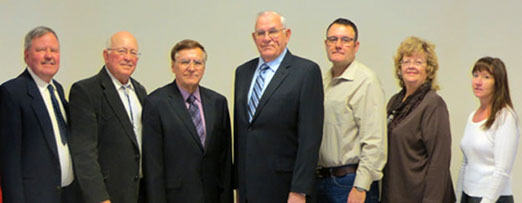

PHILLIPS COUNTY
Colorado
In January 1934, the Public Works Administration allotted Phillips County $53,000, of which about $23,000 was a grant and the remainder a loan.
A bond issue was required, so in the November 1934 election, in a 462-298 vote, the county approved a $26,000 bond issue to meet the federal grant.
In 1935, Walter Knudsen was awarded the contract to build a new county courthouse. Razing of the old building began June 17, 1935, and on Sept. 13, 1935, the cornerstone of the present-day courthouse was laid.
Colorado Gov. Ed C. Johnson was there for the ceremonies conducted by the Holyoke and Haxtun Masonic lodges. Johnson and Supreme Court Justice Hazlet P. Burke spoke to a crowd of approximately 1,000 people at the ceremony.
The new building was accepted by county commissioners on May 8, 1936, and all offices were open for business in the new facility the following week.
This structure was placed on the National Register of Historic Places on Aug. 10, 2007.
Three courthouses serve Phillips County, Continued
Settlements, post offices, schools dot Phillips County land
Phillips County has never been large—by population or by square miles—but the towns and communities that have been established in the county all have a rich history and are the places that many call home.
Holyoke was the first to be incorporated at an election held April 24, 1888.
Haxtun was incorporated July 1, 1909, with Paoli following 20 years later, Aug. 6, 1929.
All of these establishments, as well as Amherst, were laid out along the railroad in the mid-1880s.
Another railroad branch was proposed from Holyoke to Akron, but it never materialized. Therefore, settlers in the small town of Bryant, about 12 miles south of Haxtun, which would have been on that railroad, moved their buildings to Haxtun.
Located 7 1/2 miles west and 4 south of Holyoke, Emerson found itself in the same situation as Bryant along the never-completed Holyoke-Akron rail. Emerson, along with the settlement of Wakeman—7 miles east and 3 miles south of Holyoke—eventually disappeared as well.
Since homesteaders were many miles from the nearest town, rural communities were also established, such as Fairfield and Pleasant Valley, as families came together for church, baseball and other activities

Phillips County, Colorado
Communication with friends and relatives “back home” was important to settlers in early county history. Therefore, several post offices were located across the county.
Post offices and their start dates on record include Wakeman, September 1887; Holyoke, November 1887; Amherst, February 1888; Bryant, March 1888; Emerson, March 1888; Haxtum/Haxtun, April 1888; Paoli, June 1888; and Starr, February 1907.
Currently, three post offices serve Phillips County in Amherst, Holyoke and Haxtun.
As families began to settle in Phillips County, schools started to pop up along the northeast Colorado prairie.
By 1897, Phillips County had 36 separate school districts—a number that remained fairly static until 1947, when the number of districts began to dwindle. The county was reorganized in 1960, with 12 school districts in operation.
Most rural schools were grades 1-8, with branch high schools at Highland Center, Amherst, Paoli, Fairfield and Amitie. After two years there, students could continue at Phillips County High School in Holyoke.
Phillips County School Districts, in order of district number, included Fairview, Amherst, Sunnyside, Green Prairie, Pleasant Valley, Highland Center, Prairie Star, Evergreen, Hilltop, Sunbeam, Plainview, Mc¬Kelvey, Pleasant Prairie, Pleasant View, Silverbeam, Sunny Dale, Beachville, Grandview, Harmony, Prairie Gem, White Star, Highline, Holyoke, Liberty, Fairfield, Morning View, Fairy Dell, Philorado, Meakins/Glenwood, Morning Star, Amitie, Paoli, Communty Center, Broadway, Lone Star, Lakeside, Haxtun and North Star.
Today, Phillips County has two school districts in Holyoke and Haxtun.

Phillips County officials gather together for a photo in 1931. They are pictured from left, front row, Hattie Cole Lingo, librarian; Estelle Brinkley Sanders, deputy assessor; Florence Stack Silligman, clerk of county court; Edna Youtsey, superintendent of schools; Edith Correll, clerk and recorder; and Geneva Behnfeldt Hassler, deputy clerk of district court; second row, Mrs. Chas. Morris, janitor; R. Claymon, commissioner; Ed W. James, bailiff district court; Steve J. Meakins, commissioner; Frank McElroy, yard caretaker; Henry C. Hargreaves, deputy treasurer; Thomas Hargreaves, treasurer; and Olin H. Helland, clerk district court; and back row, Smith S. Worley, judge; A.C. Correll, clerk and recorder; John Sandquist, commissioner; Frank A. Berger, sheriff; Roy E. Owens, assessor; and Ben L. Garman, attorney.
County marks 125th anniversary
While it was the railroad that really kicked off activity in northeast Colorado, the agriculture industry as well as other strong businesses keep the people of Phillips County thriving in 2014, its 125th year.
As of the 2010 census, the population of Phillips County was 4,442 people—the people who work hard to make the county what it is today.
“We celebrate what we as a county can provide to our citizens,” said current Phillips County Commissioners Harlan Stern, Don Lock and Joe Kinnie.
“We celebrate you, the hearty souls who continue to invest yourselves and continue to make this a great place to live. We delight in seeing our children raised with rural values and a great work ethic. Throughout the year of 2014, we hope to celebrate 125 years.”

Current officials at the Phillips County Courthouse are pictured from left, Administrator Randy Schafer, Commissioner Joe Kinnie, Commissioner Harlan Stern, Commissioner Don Lock, Assessor Doug Kamery, Treasurer Linda Statz and Clerk and Recorder Beth Zilla.

All materials contained on these pages are furnished for the free use of those engaged in researching their family origins. Any commercial use, without the consent of the host/author of these pages is prohibited. All images used on these pages were obtained from sources permitting free distribution, or generated by the author, and are subject to the same restrictions/permissions. All persons contributing material for posting on these pages does so in recognition of their free, non-commercial distribution, and further, is responsible to assure that no copyright is violated by their submission.
Last updated December 2018
